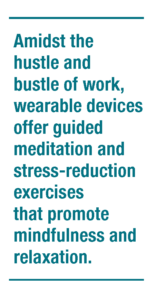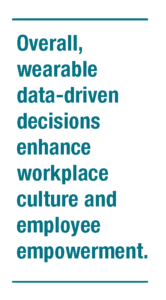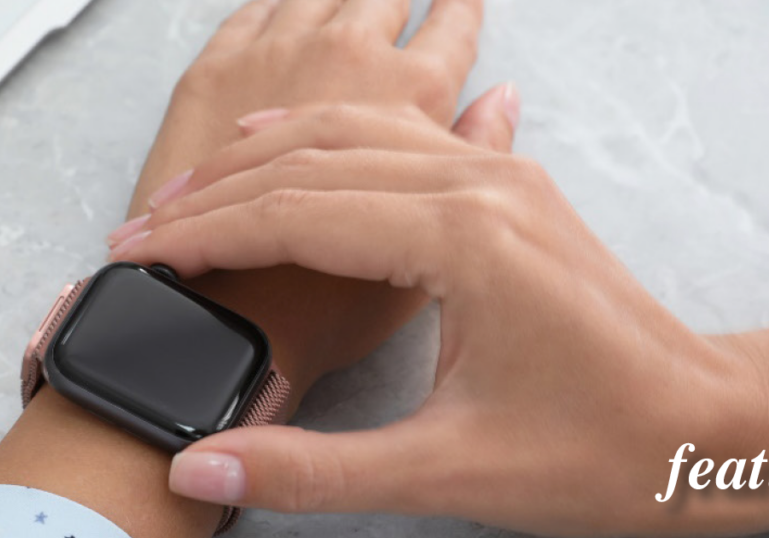Introduction
HR professionals and leaders face immense pressure and responsibility in today’s fast-paced, high-stress work environments. The resulting burnout and health issues for themselves and their employees have become significant concerns for organizations. However, wearable technology is an innovative solution to help manage stress, improve well-being, and maintain optimal employee performance. This article will explore how wearable devices can be crucial in identifying and addressing employee burnout while enhancing overall health for employees, HR professionals, and leaders.
1. Understanding Burnout and Health Issues in HR:
The toll of burnout on employees cannot be underestimated. It manifests as physical, emotional, and mental exhaustion caused by chronic stress from demanding tasks like employee management, conflict resolution, and decision-making. Workplace programs that promote well-being and avoid burnout increase productivity and work satisfaction. 1
Employees are particularly vulnerable to burnout due to their high-stress roles. The fatigue, cynicism, and sense of inefficacy can severely impact their physical and mental health. Headaches, gastrointestinal issues, insomnia, anxiety, and depression are common manifestations.
2. The Mechanics of Wearable Devices and Health-Monitoring Features:
Unlocking the true potential of wearable devices begins with understanding how they operate. These intelligent tools, such as smartwatches and fitness trackers, are equipped with sensors that collect essential data on various health parameters. They track heart rate, sleep patterns, physical activity, and stress levels, among other metrics. With this knowledge, HR professionals and leaders can harness wearable technology to combat burnout and improve health.
Advanced wearables utilize ECG, SpO2, and EDA sensors for in-depth health insights. The wealth of biometrics empowers users to understand their bodies better. 2
3. Stress Monitoring: A Vital Tool in Stress Management:
The real-time insights of wearable devices, particularly those with heart rate variability (HRV) sensors, allow people to monitor their stress levels throughout the day. They can promptly adopt effective stress management techniques by identifying stress triggers, thus preventing burnout. 3 This section emphasizes the significance of personal stress monitoring as a powerful tool for promoting well-being.
HRV refers to the variation in time intervals between heartbeats. Lower HRV indicates high-stress levels and potential burnout. Wearables track HRV to help users recognize stressful situations and moments when they need to reset. Features like guided breathing prompt users to regain composure. Over time, consistent stress monitoring builds self-awareness and resilience. Employees can also share anonymized HRV data with leadership to demonstrate periods of high workplace stress requiring intervention. Thus, stress monitoring via wearables is invaluable for combating burnout.
4. Encouraging Physical Activity and Its Benefits:
Sedentary habits contribute significantly to stress and health issues. Wearable devices that track physical activity are constant motivators, inspiring HR professionals and leaders to exercise regularly. Physical activity boosts physical health, enhances mood, and reduces stress. This section passionately highlights the importance of movement in building resilience.
Wearables encourage users to stay active by:
- Tracking steps, distance, calories burned, and active minutes
- Set daily movement goals and reminders
- Monitor heart rate during workouts
- Provide personalized training plans
Beyond motivation, wearables also enhance workout safety by alerting users if their heart rate or intensity is too high.
5. Sleep Tracking for Enhanced Rest and Recovery:
Amid demanding work schedules, employees often struggle to maintain healthy sleep routines. Wearable devices with sleep-tracking capabilities offer valuable insights into sleep patterns and quality. They can achieve mental and physical rejuvenation by making informed adjustments to improve sleep hygiene. This section advocates for restful sleep as a crucial pillar of well-being.
achieve mental and physical rejuvenation by making informed adjustments to improve sleep hygiene. This section advocates for restful sleep as a crucial pillar of well-being.
Wearables track sleep duration, consistency, and quality by monitoring heart rate, motion, and breathing patterns. The data reveals issues like sleep debt, nighttime awakenings, light versus deep sleep percentages, and irregular schedules. Well-rested employees have enhanced focus, performance, and mental health. Organizations respecting healthy sleep as integral to productivity gain immense benefits. Ultimately, wearable sleep tracking is indispensable for combating workplace burnout.
6. Mindfulness and Stress-Reduction Techniques:
Amidst the hustle and bustle of work, wearable devices offer guided meditation and stress-reduction exercises that promote mindfulness and relaxation. Employees can effectively manage stress, improve focus, and develop mental resilience through these practices.
Mindfulness meditation apps synced to wearables provide short guided breathing exercises, body scans, and visualizations. Random reminders prompt users to pause and reset mentally. Mindful movement exercises leverage step count and heart rate data for customized intensity. Tracking respiratory rate enables breathwork guidance.
7. Personalized Recommendations and Real-Time Alerts:
Wearable devices deliver personalized recommendations and real-time alerts based on users’ data – a feature that serves as a lifeline, reminding people to take breaks, engage in relaxation techniques, or embrace physical activities during demanding work hours. These timely interventions significantly contribute to stress reduction and overall well-being.
Wearables provide real-time guidance like prompting movement when inactive for too long or suggesting breathing exercises when heart rate spikes. Personalized monthly challenges encourage new fitness habits and healthy competition. Rotating specialty workouts prevent boredom. Wearables empower users to set boundaries and take breaks by muting non-urgent notifications.
8. Tracking Progress and Goal Setting:
Wearable devices empower users to track their progress and set personalized health and wellness goals – to establish realistic objectives for stress reduction, physical activity, and sleep improvement. Monitoring progress further motivates individuals to maintain a healthier lifestyle and avoid burnout.
Goal-setting features allow users to choose from pre-set options or create custom targets for steps, workouts, sleep duration, mindfulness minutes, and more. Progress bars encourage users to complete their goals and earn rewards. Long-term trends reveal successes versus setbacks. Reminders keep users accountable.
9. Data Privacy and Ethical Considerations:
While wearable technology offers boundless benefits, ensuring data privacy and ethical usage is paramount. Organizations must uphold transparency, protect personal data, and obtain informed consent from users. This section underscores the ethical implications of wearable technology implementation.
Although wearables collect sensitive health data, users maintain data ownership and control sharing. Organizations should obtain explicit consent for receiving identifiable data. 4 Wearable initiatives must communicate the following:
- Exactly what data is collected and stored
- How it is aggregated, anonymized, and secured
- Who can access the data, and for what specific purposes
- Retention policies and procedures for deleting data
- Opt-out policies for discontinuing data access
Upholding transparency and consent while protecting privacy maintains trust and ethical standards.
10. Integration Challenges and Solutions:
As organizations adopt wearable technology, challenges may arise, including employee resistance, data integration, and confidentiality issues. This section provides impactful solutions, advocating for employee buy-in, thorough training, and seamless system integration as crucial to successful implementation.
Organizations can offer incentives like wearable subsidies or rewards for participation to encourage employee buy-in. Demonstrating how wearables enhance workplace experience versus exerting control is critical. Thorough training ensures correct device usage while setting expectations. With proper consent, APIs smoothly transfer data from wearables to organizational platforms for data integration. Strict access policies maintain confidentiality across applications. With pragmatic solutions, organizations can overcome integration hurdles and maximize wearable ROI.
11. Empowering HR Professionals and Leaders with Wearable Data:
With invaluable insights from wearable devices, employees can make informed decisions to optimize work-life balance and well-being. This section explores how wearable data can be translated into actionable steps, such as creating personalized wellness plans, adopting effective time management strategies, and fostering a culture of well-being within the organization.
Wearable data patterns and energy level ratings allow users to identify peak productivity times to strategize schedules. Aggregated team data can pinpoint low engagement periods to guide scheduling adjustments. Notifications encourage regular breaks, stretching, and moving to maintain energy levels. Leaders make more empowered choices by discovering their unique stress cycles and energy rhythms.
12. Supporting Mental Health through Wearable Technology:
The detrimental effects of burnout extend to mental health concerns, such as anxiety and depression. Wearable devices with mental health tracking capabilities offer support through mood monitoring, stress-reducing exercises, and guided relaxation techniques. 5 This section passionately champions mental health as a cornerstone of burnout prevention.
Wearables assessing HRV, sleep, activity levels, and social engagement provide objective indicators of potential mental health issues. Users complete periodic mood logs within companion apps.
13. Utilizing Wearable Data for Organizational Strategies:
Aggregate data from wearable devices provides valuable insights into workforce well-being trends, stress triggers, and areas for improvement. HR departments can harness this anonymized data to design targeted wellness programs, create flexible work policies, and enhance employee satisfaction. This section celebrates wearable data as a catalyst for organizational well-being strategies.
Analyzing aggregated wearable data points like sleep quality, exercise frequency, and changing stress levels allows organizations to identify challenges. Program adjustments can address high-stress periods needing flexible schedules or low-activity periods requiring fitness challenges. Overall, wearable data-driven decisions enhance workplace culture and employee empowerment. 5
14. The Role of Leadership in Promoting Wearable Technology:
Leadership plays a pivotal role in fostering workplace well-being. This section emphasizes the significance of leadership support in encouraging wearable technology adoption and cultivating a culture that prioritizes employee health and burnout prevention.
When leadership partakes in wearable technology personally, it powerfully signals prioritization of well-being from the top down. Leading by example motivates teams. Providing wearables and meditations spaces and tracking progress together builds unity. Transparent communication about benefiting from mindfulness, sleep, and balanced schedules inspires trust.
15. Monitoring the Impact and ROI of Wearable Technology:
Ensuring the efficacy of wearable technology in combating burnout and improving health requires measuring its impact and return on investment (ROI). This section highlights key performance indicators (KPIs) for assessing wearable technology initiatives’ success and refining strategies based on data analysis.
Relevant KPIs include:
- Participation rates
- Program engagement and feature usage
- User satisfaction surveys
- Stress level trends
- Productivity metrics
- Healthcare cost data
Comparing KPIs before and after program implementation demonstrates tangible ROIs like lower healthcare spending, reduced absences, and increased output. Annual surveys provide user feedback for enhancements. Ultimately, performance tracking ensures wearable technology initiatives deliver measurable well-being improvements.
16. Addressing Potential Drawbacks and Ethical Concerns:
While wearable technology offers boundless potential, acknowledging potential drawbacks and ethical considerations is essential. Safeguarding data privacy, preserving employee autonomy, and avoiding over-reliance on technology is paramount. This section passionately advocates for responsible usage of wearable devices. 6
Organizations must ensure that wearable programs are entirely voluntary and avoid penalizing non-participants. Open data policies and strict access controls prevent misuse. Training emphasizes balancing technology with in-person interactions and support.
Conclusion
Wearable technology is a transformative approach to combat employee burnout and elevate HR professionals’ and leaders’ health and well-being. By actively monitoring stress levels, physical activity, and sleep patterns, wearable devices empower individuals to take charge of their well-being and achieve peak performance. Ethical considerations, data privacy, and practical implementation form the foundation of a responsible integration of wearable devices in the workplace. As wearable technology continuously evolves, its potential to reshape workplace well-being and burnout prevention for HR professionals and leaders remains boundless. Together, let us embrace the power of wearable technology to unlock new heights of personal and organizational well-being.
ENDNOTES
1 Edú-Valsania, S., Laguía, A., & Moriano, J. A. (2022). Burnout: A review of theory and measurement. International Journal of Environmental Research and Public Health, 19(3), 1780, https://bit.ly/45e9soQ.
2 Randazzo, V., Ferretti, J., & Pasero, E. (2020). A wearable smart device to monitor multiple vital parameters—VITAL ECG. Electronics, 9(2), 300, https://bit.ly/3YGmER5.
3 Shei, R. J., Holder, I. G., Oumsang, A. S., Paris, B. A., & Paris, H. L. (2022). Wearable activity trackers–advanced technology or advanced marketing? European Journal of Applied Physiology, 122(9), 1975-1990, https://bit.ly/3sm3wvH.
4 Tu, J., & Gao, W. (2021). Ethical considerations of wearable technologies in human research. Advanced healthcare materials, 10(17), 2100127, https://bit.ly/3KNrZ3c.
5 Hunkin, H., King, D. L., & Zajac, I. T. (2020). Perceived acceptability of wearable devices for the treatment of mental health problems. Journal of clinical psychology, 76(6), 987-1003, https://bit.ly/3qy00hd.
6 Marr, B. (2018). Data-driven HR: how to use analytics and metrics to drive performance. Kogan Page Publishers, https://bit.ly/47AdAkR.

